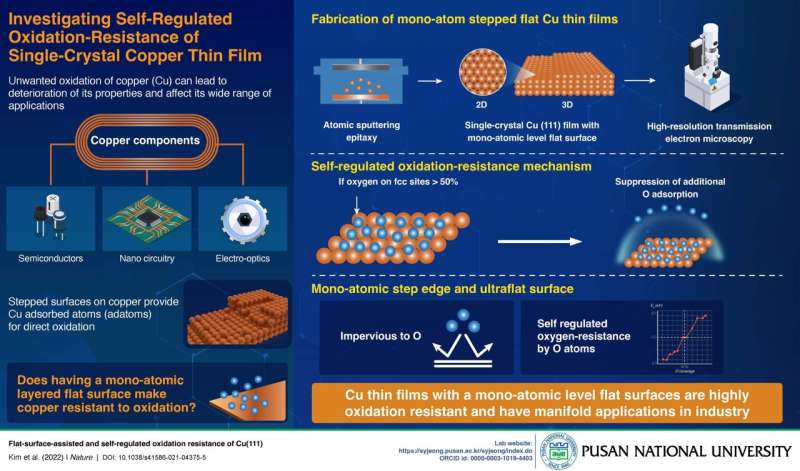Researchers develop 'corrosion-free' copper thin films

Copper (Cu) is of fundamental importance to our daily lives due to its excellent electrical conductivity, as well as other valuable physical properties, such as the ability to draw copper into thin wires. Cu is the metal that is at the heart of the electronics, semiconductor and electro-optics industry. But oxidation and unwanted corrosion on its surface can limit the lifespan and increase the electrical resistance of Cu. Now, a team of researchers led by Prof. Se-Young Jeong from Pusan National University have developed a way to fabricate oxidation-resistant thin films of copper. "Oxidation-resistant Cu could potentially replace gold in semiconductor devices, which would help bring down their costs. Oxidation-resistant Cu could also reduce electrical consumption, as well as increase the lifespan of devices with nanocircuitry," says Prof. Jeong. The study has been published in Nature.
Previous studies have shown that Cu oxidation occurs due to microscopic "multi-steps" on the surface of copper. These steps provide a source of Cu adatoms (adsorbed atoms), which interact with oxygen and provide a place for oxides to grow. This is why single-crystalline Cu is resistant to oxidation. "We used a method called atomic sputtering epitaxy to grow tightly coordinated flat single-crystal copper films. By using noise reduction systems to reduce electrical and mechanical noises, we were able to keep the Cu surfaces nearly defect-free and fabricate atomically flat films," explains Prof. Jeong.
The research team then used high-resolution transmission electron microscopy (HR-TEM) to study the Cu films. They found that the film grew in the [111] direction and had an almost flat surface with occasional mono-atomic steps. They then compared the single-crystal Cu (111) films (SCCFs) with other Cu films which had higher surface roughness and found that unlike with the other films, the SCCFs were oxidation-resistant, i.e., it is very difficult for oxygen to penetrate the mono-atomic step edge.
The researchers then used a microscopic model of Cu oxidation based on "density functional theory" to investigate how the SCCF interacts with oxygen. They found that the surface of the SCCF was protected by oxygen itself, once 50% of its surface was covered with oxygen atoms. Additional absorption of oxygen atoms on the SCCF was suppressed by the high energy barrier they, themselves, created.
"The novelty of our research lies in the realization of atomically flat surfaces, i.e., surfaces that are flat on the atomic level, as well as an elucidation of the oxidation-resistance mechanism of ultraflat metals," concludes Prof. Jeong.
The findings of this study make major contributions not only to the electronics and semiconductor industry, but also go a long way towards helping protect priceless bronze sculptures from damage.
More information: Su Jae Kim et al, Flat-surface-assisted and self-regulated oxidation resistance of Cu(111), Nature (2022). DOI: 10.1038/s41586-021-04375-5
Journal information: Nature
Provided by Pusan National University





















